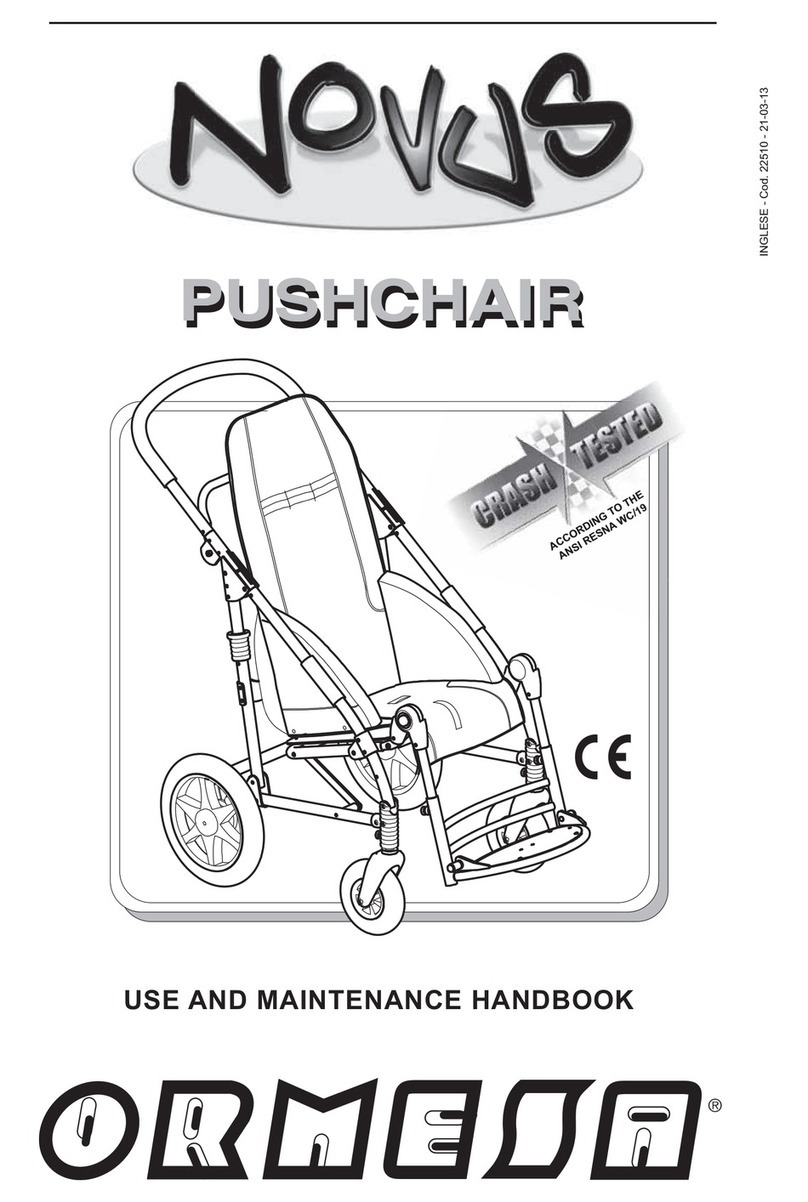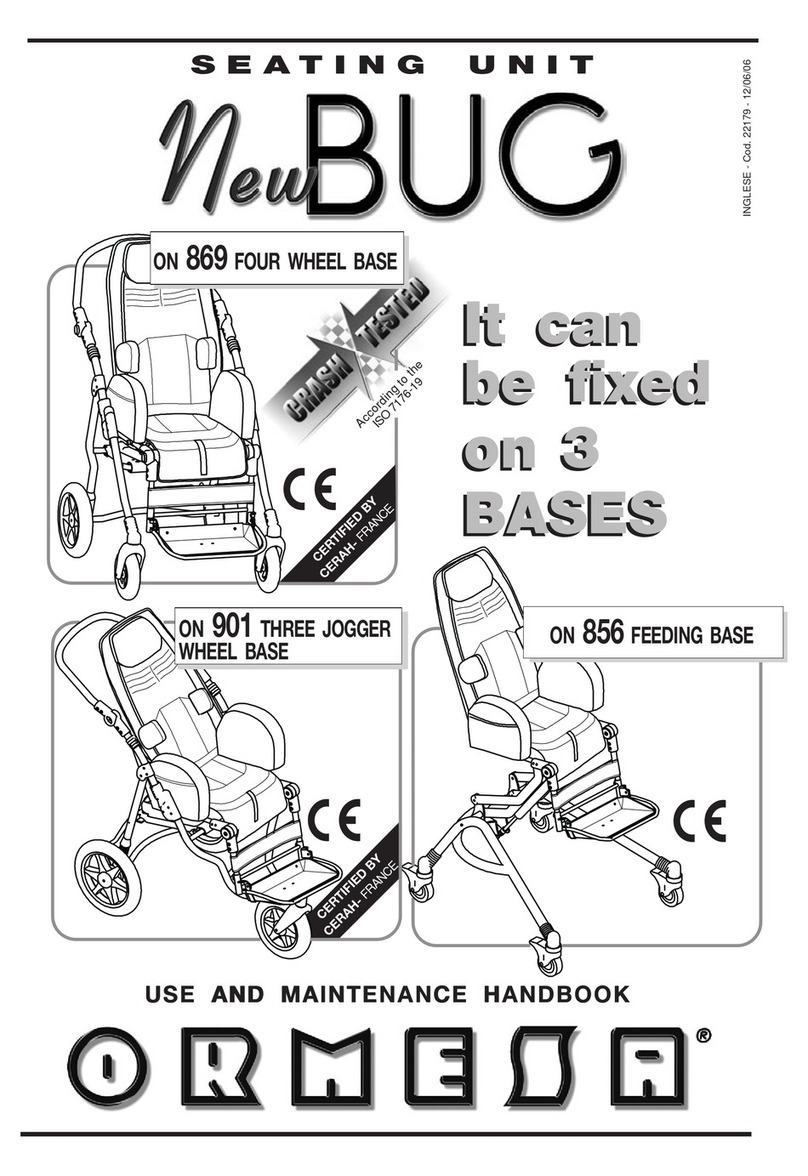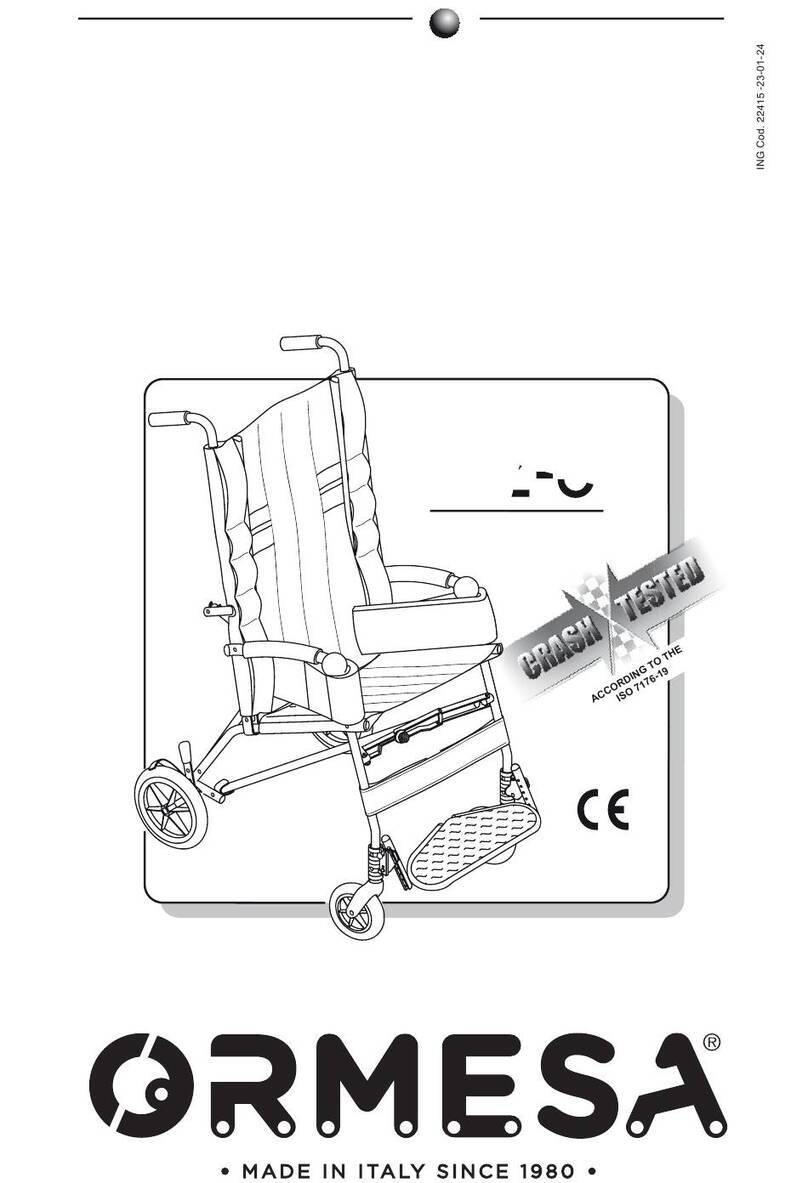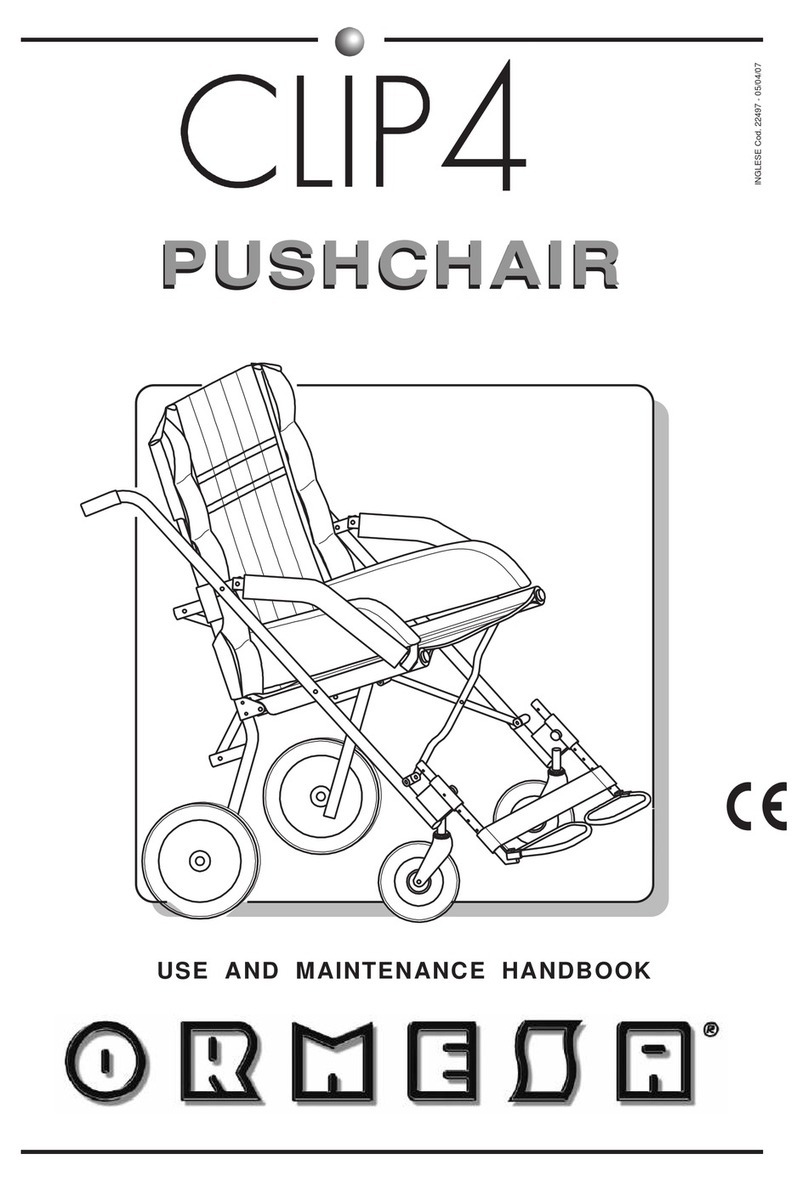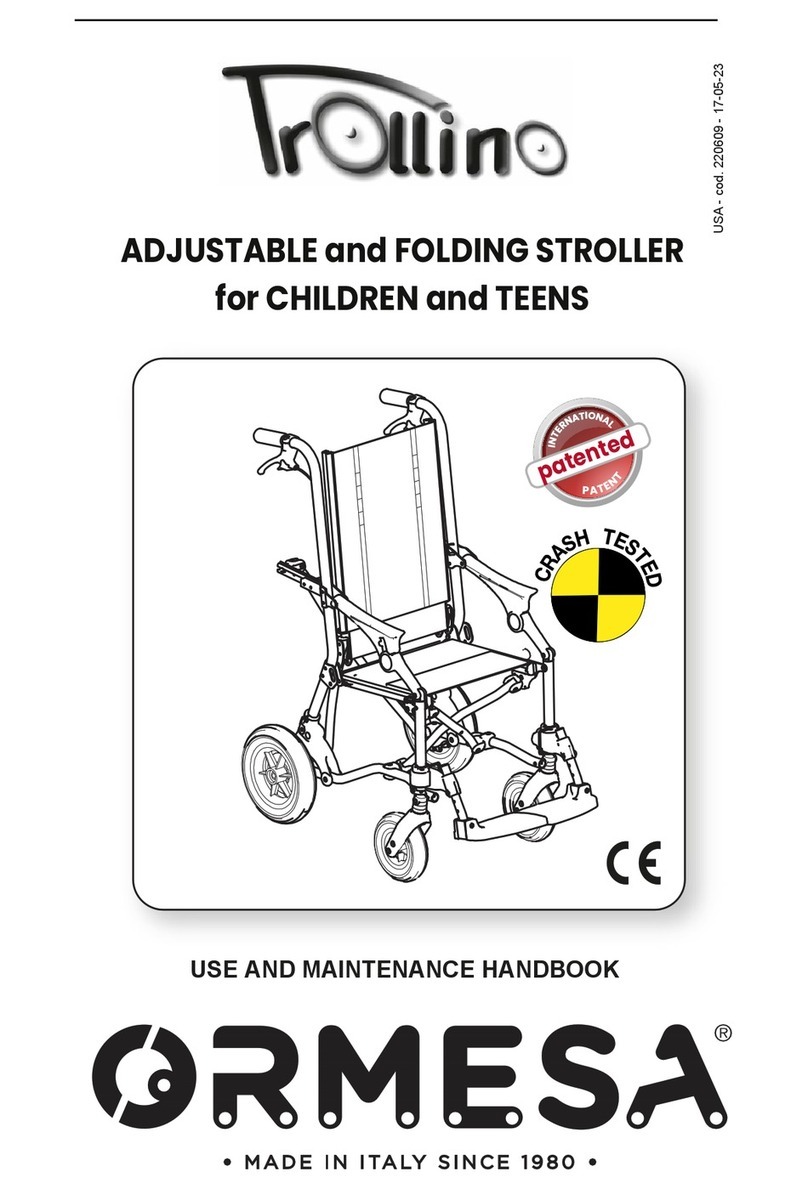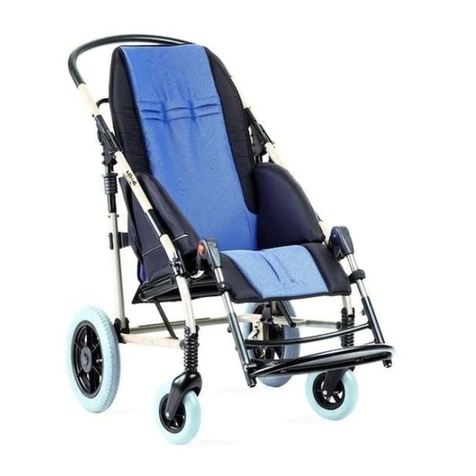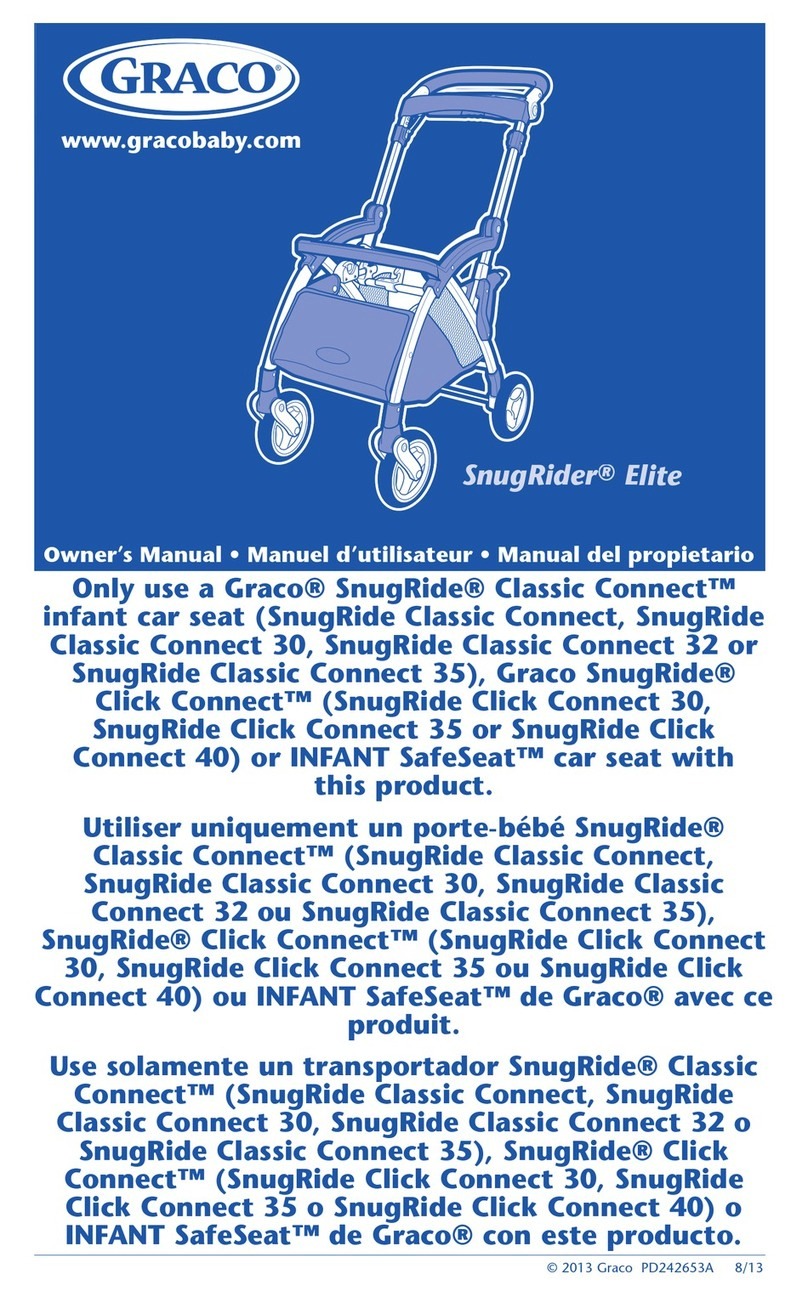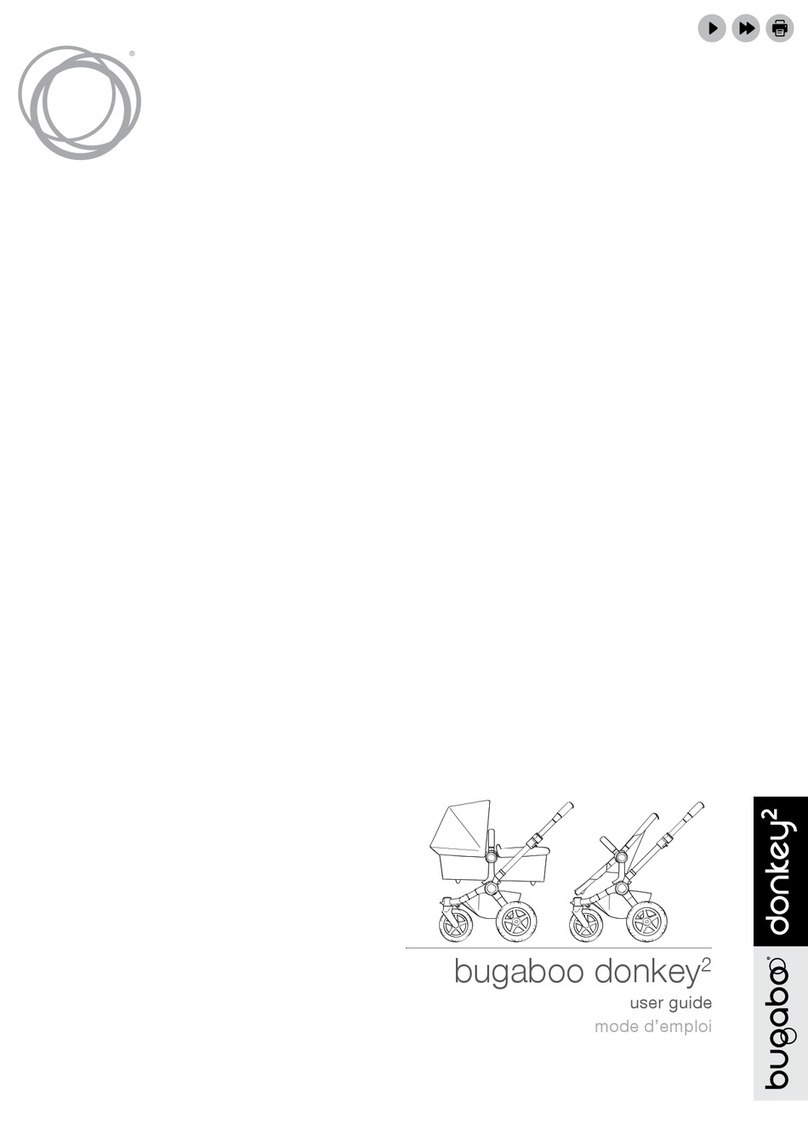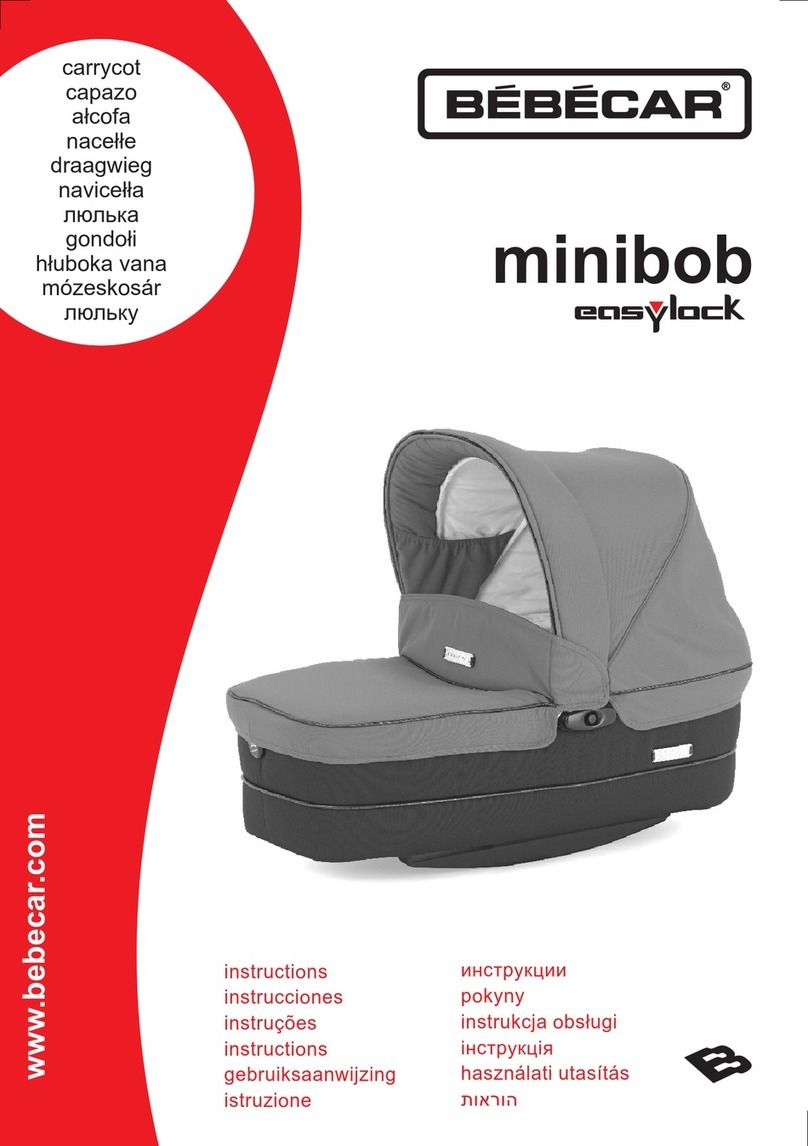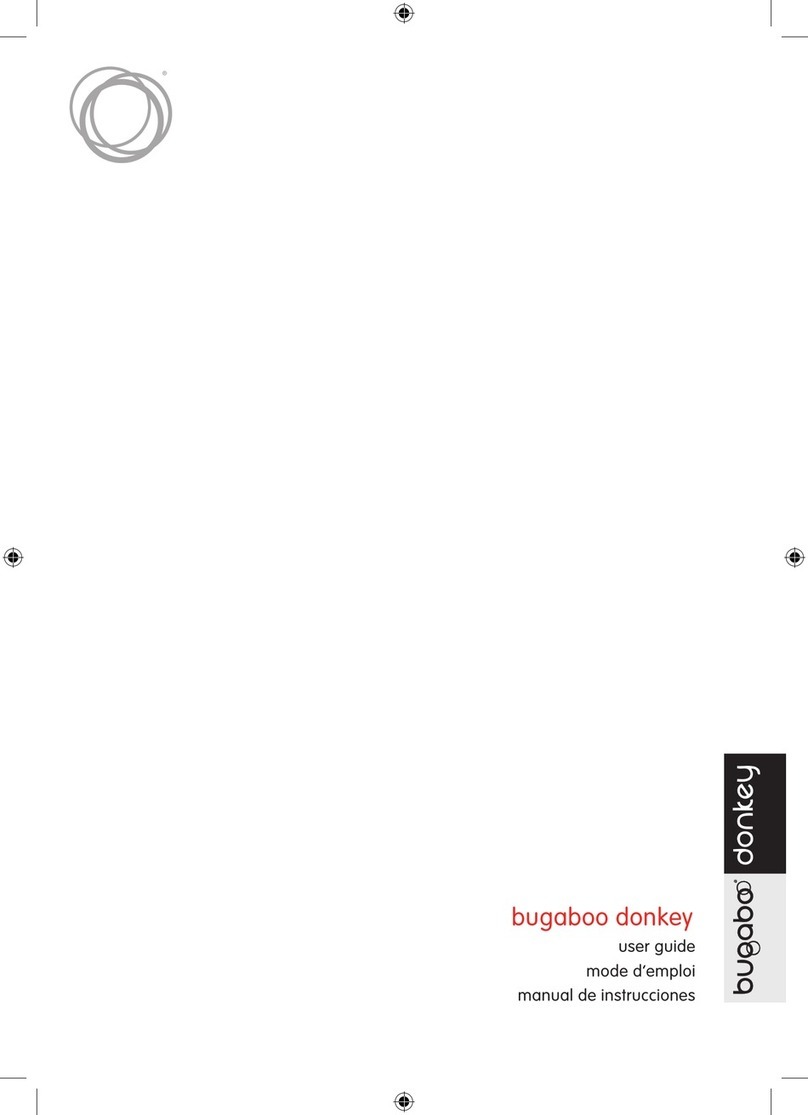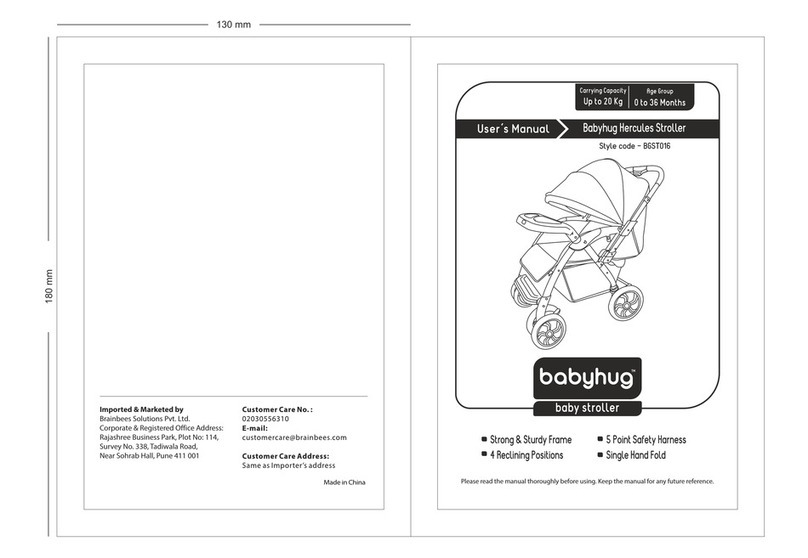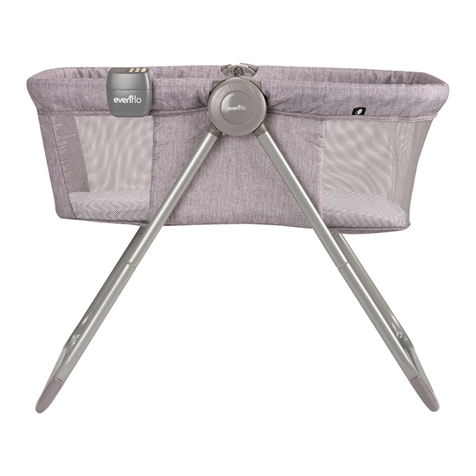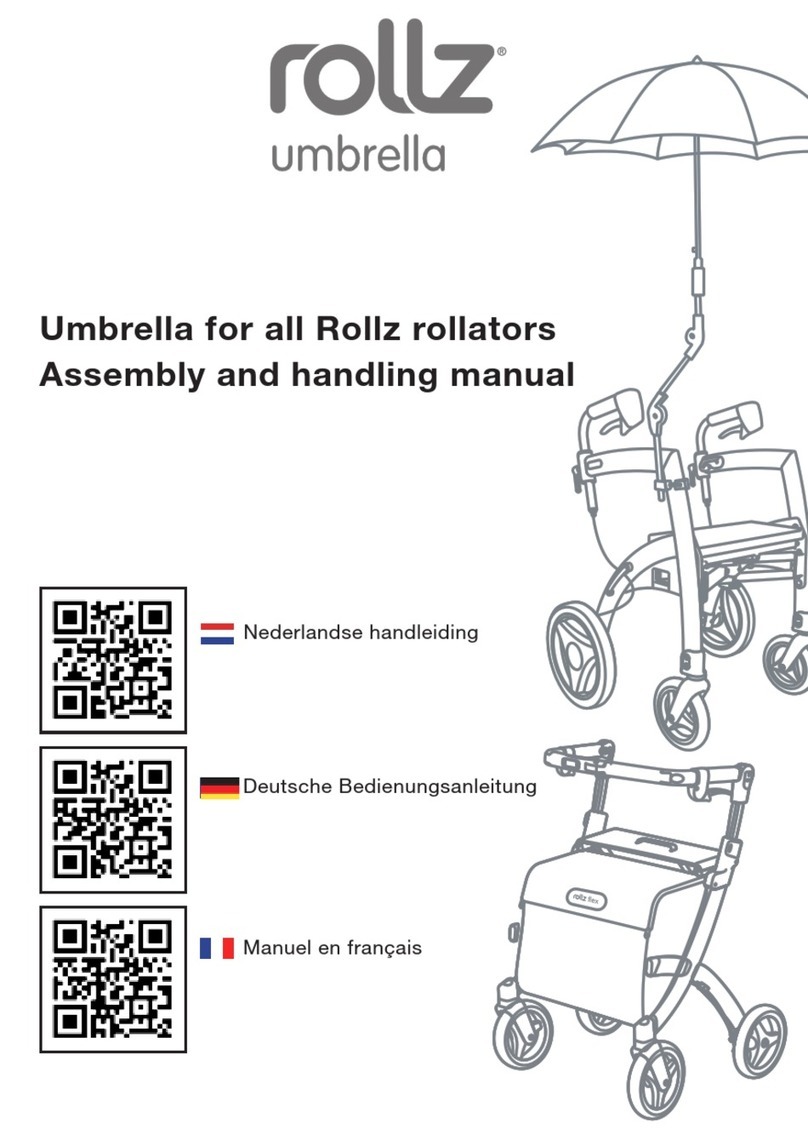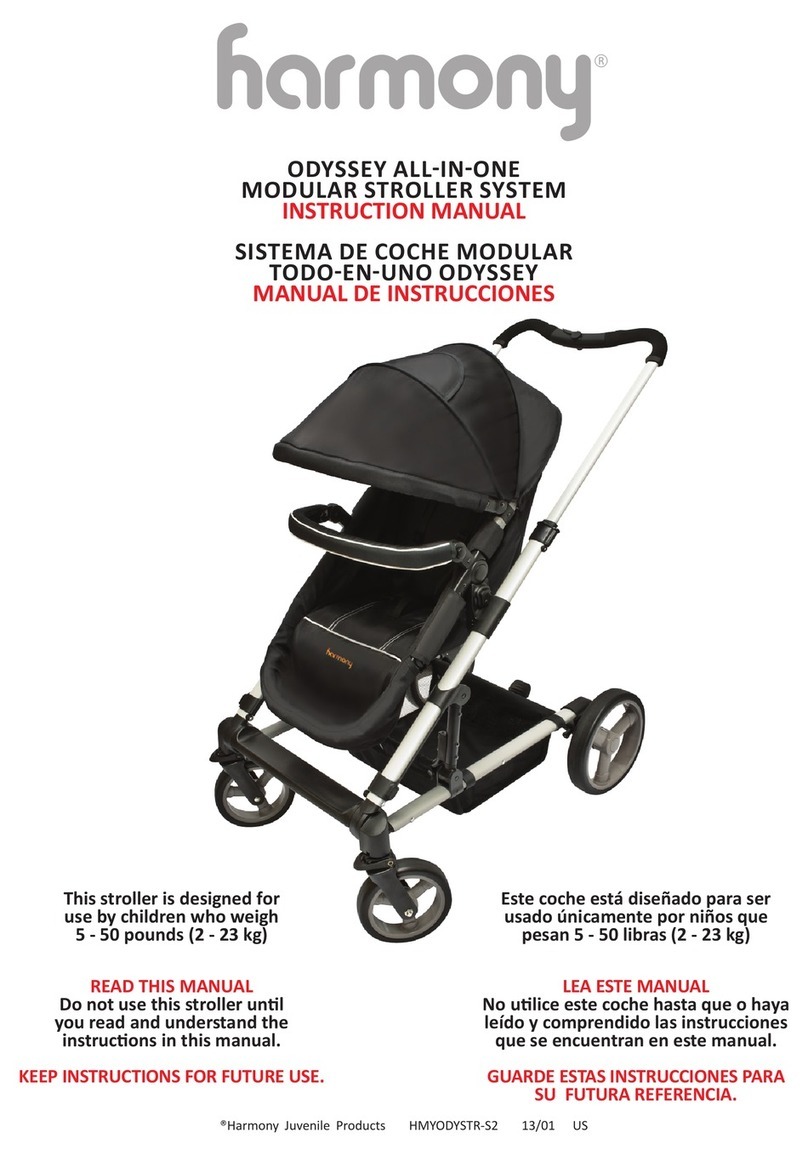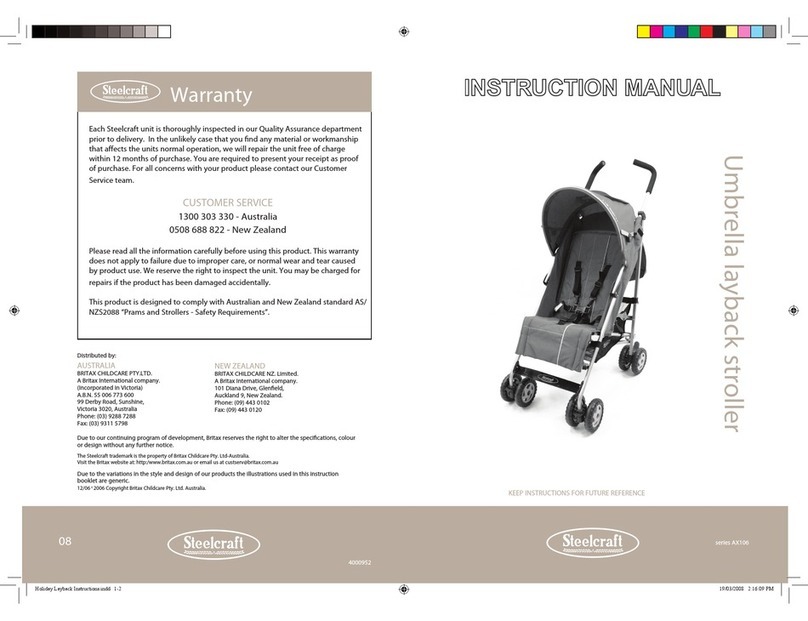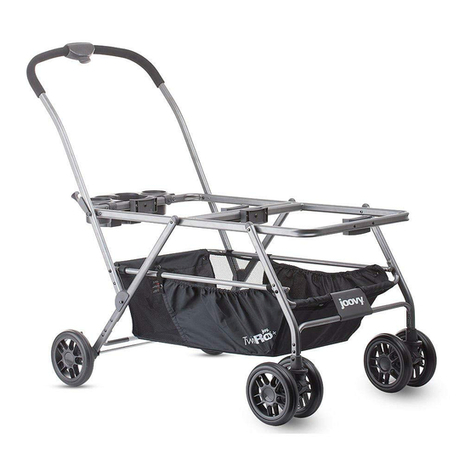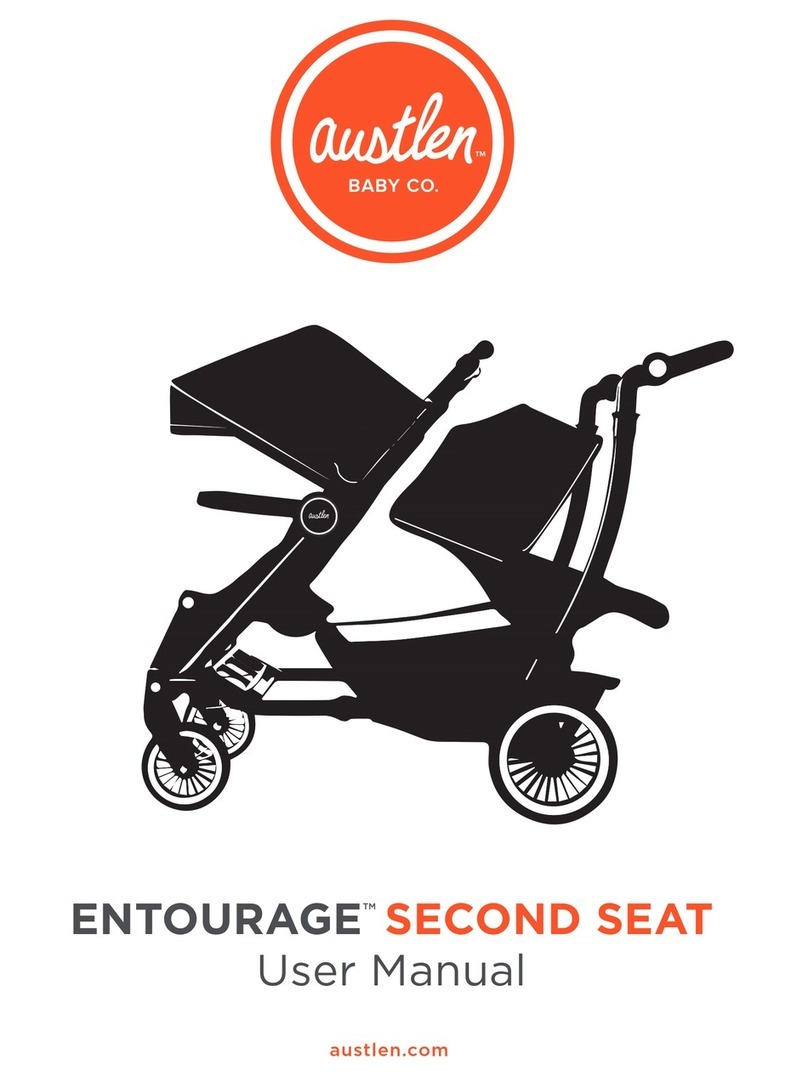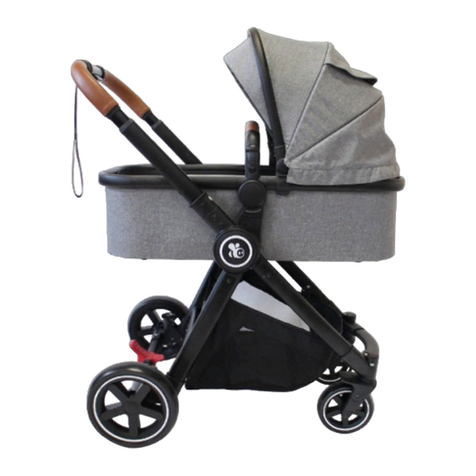Ormesa BUG Manual

INGLESE - Cod. 22919 - 15-03-19
USE AND MAINTENANCE HANDBOOK
modular seating system
COMPACT FLOOR BASE
850
ISO 7176/19
ANSI RESNA WC/19
HI-LOW FEEDING BASE
856
HI-LOW COMPACT BASE
851
with
INDOOR BASES
FOUR-WHEEL BASE
869
with
OUTDOOR BASE
SEAT UNIT


Thank you for choosing Bug, from ORMESA s.r.l.
The Bug combines style and ergonomics without compromising on safety.
Bug is a complete seating system with recline and tilt space, that grows with your child. It
can be placed on any flat surface and it is available with three different base units (4 wheel base
and 3 wheel base for outdoor use; feeding base for indoor use).
ORMESA s.r.l. recommends that you read this manual very carefully to understand its
contents fully. In addition to help you become familiar with the seat quickly, it also contains
practical tips for making the best use of it safely and keeping it in good working order.
If, after reading it, you still have questions, contact your retailer, who will be happy to help you, or
call ORMESA directly at +39 0742 22927, send a fax to +39 0742 22637 or send an e-mail to:
Luigi Menichini
Managing Director
1/104

TABLE OF CONTENTS
WARNINGS.................................................................................................................................... 4
GUARANTEE ................................................................................................................................. 9
HOW TO STORE AND TRANSPORT THE MEDICAL DEVICE ..................................................... 9
CONFORMITY DECLARATION CE ............................................................................................. 10
SOME EXAMPLES OF WHAT NOT TO DO WITH THE PRODUCT............................................... 11
HOW TO TILT THE BUG AND CLIMB UP PAVEMENTS .............................................................. 12
HOW TO USE THE BUG 4-WHEEL STROLLER WITH 869 BASE FOR TRANSPORT ON A
MOVING VEHICLE (private cars, buses, etc.).............................................................................. 13
LABELS AND PLATES.................................................................................................................. 18
WHAT Bug IS................................................................................................................................. 19
TECHNICAL FEATURES ............................................................................................................... 19
BASE 869 BRAKING ................................... .................................................................... 20
BASE 856 BRAKING ..................................................................................................................... 20
INITIAL PREPARATION ................................................................................................................ 21
PACKAGING INFORMATION .................................................................................................... 21
HOW and WHERE TO HOLD the COMPONENTS of BUG, in SAFETY ..................................... 21
Bug SEAT UNIT ............................................................................................................................. 22
SEATING UNIT ADJUSTMENTS ................................................................................................... 23
ADJUSTING THE INCLINATION OF THE SEAT (TILT-IN-SPACE SYSTEM) ............................ 23
RECLINING THE BACKREST.................................................................................................... 24
ADJUSTING THE HEIGHT OF THE BACKREST....................................................................... 25
ADJUSTING THE WIDTH OF THE SEAT BASE ........................................................................ 26
ADJUSTING THE LEGREST...................................................................................................... 27
ADJUSTING THE FOOTREST................................................................................................... 28
ADJUSTING THE DEPTH OF THE SEAT .................................................................................. 29
Bug seat with 4-WHEEL base 869............................................................................................... 30
TECHNICAL SPECIFICATIONS of Bug with four wheel BASE 869 ............................................ 31
HOW TO USE Bug WITH BASE 869 ............................................................................................. 33
OPENING the STROLLER........................................................................................................ 33
HOW TO ATTACH THE SEAT TO THE FRAME ........................................................................ 34
HOW TO REVERSE THE SEAT SO THAT THE CHILD FACES HIS MOTHER(FIG.A).............. 35
HOW TO DETACH THE SEAT FROM THE FRAME .................................................................. 36
FOLDING THE BASE............................................................................................................... 37
ADJUSTING THE INCLINATION OF THE HANDLE................................................................... 38
FRONT WHEEL DIRECTION LOCKS ........................................................................................ 38
Bug seat with INDOOR base 856................................................................................................. 39
TECHNICAL SPECIFICATIONS of Bug with BASE 856.............................................................. 40
HOW TO USE Bug WITH BASE 856 ............................................................................................ 41
HOW TO ATTACH THE SEAT TO THE FRAME ........................................................................ 41
HOW TO DETACH THE SEAT FROM THE FRAME .................................................................. 42
2/104

ADJUSTING THE HEIGHT OF THE SEAT................................................................................. 43
Bug seat with INDOOR base 850 and851 .................................................................................... 45
TECHNICAL SPECIFICATIONS of Bug with BASE 850............................................................... 46
TECHNICAL SPECIFICATIONS of Bug with BASE 851............................................................... 47
HOW TO USE Bug with BASE 850 and 851................................................................................. 48
HOW TO ATTACH THE SEAT TO THE FRAME........................................................................ 48
HOW TO DETACH THE SEAT FROM THE FRAME .................................................................. 50
ADJUSTING THE HEIGHT OF THE SEAT with BASE 851 ........................................................ 52
BASE 851 BRAKING.................................................................................................................. 53
ACCESSORIES ............................................................................................................................. 54
MOUNTING THE ACCESSORIES ................................................................................................. 54
HEADREST with OCCIPITAL-PARIETAL PROTECTIONS !"#$............................................... 54
ERGONOMIC HEADREST %&'#.................................................................................................. 56
HEADREST with PARIETAL PROTECTIONS (' ................................................................... 59
LEG DIVIDING INGUINAL STRAPS )*.................................................................................. 61
THERMIC COVER ) ............................................................................................................. 61
CANOPY )%#........................................................................................................................... 62
RAIN COVER '( .................................................................................................................... 63
FOOT STRAPS '*#................................................................................................................. 64
Padded ABDUCTION BLOCK "&# .......................................................................................... 64
ADJUSTABLE ABDUCTION BLOCK "&+ ................................................................................ 65
FRONT HANDLE# "%................................................................................................................. 68
FLEXIBLE AND WRAP-AROUND SIDE SUPPORTS FOR THE TRUNK ! ............................ 69
891 TIEDOWN HOOKS (4 RINGS) %) ..................................................................................... 70
VEST HARNESS ("............................................................................................................... 70
NET BASKET ( .................................................................................................................... 71
45° SEAT BELT %&................................................................................................................. 71
Padded SIDE SUPPORTS " ................................................................................................ 72
TRAY '&................................................................................................................................. 73
TRA Y for BUG WITH 856, 851 and 850 BASES '&,............................................................... 74
5-POINT VEST HARNESS %-" ................................................................................................ 77
5-POINT HARNESS %-! .......................................................................................................... 78
PARASOL (& ......................................................................................................................... 80
PADDED COVERING for FOOTPLATE %'............................................................................. 83
HAND BRAKE %-( ................................................................................................................... 84
VENT TRAY %)) ...................................................................................................................... 89
OXYGEN BOTTLE HOLDER %"(#............................................................................................. 91
4-POINT SEAT BELT %'- ........................................................................................................ 94
SIBLING REAR FOOTBOARD %')#.......................................................................................... 96
BOTTLE HOLDER %''............................................................................................................. 99
ATTACHING THE CUSHION ......................................................................................................... 100
MAINTENANCE, CLEANING AND DISINFECTION ...................................................................... 102
CUSTOMER SERVICE AND SPARE PARTS ................................................................................ 103
CONDITIONS FOR DURABILITY, REUSE AND REASSIGNMENT TO A NEW USER ................ 104
3/104

WARNINGS
-CAREFULLY READ AND UNDERSTAND THE INSTRUCTIONS IN THIS MANUAL
BEFORE USING THE DEVICE BECAUSE THEY HAVE BEEN WRITTEN WITH
THE USER'S SAFETY IN MIND and they will help the carer use the product safely
and keep it in good working order. The Use and Maintenance Manual is an integral
part of the product and must be carefully preserved for future reference.
-The manual is intended for technically qualified retailers and users and their
assistants; it provides instructions for its correct use and must be supplemented by
adequate knowledge of the rehabilitation program for which it has been prescribed.
-The manual reflects the technical state of the product at the time it was sold.
ORMESA s.r.l. reserves the right to make any changes to the product or manual
suggested by experience, technical considerations or regulatory developments
without any obligation to update its previous production and relevant manual.
-The use of the device and its accessories must be checked by a specialized
doctor, in conformity with the laws and standards in force.
-The Bug is intended for use by people whose size and weight fall within the
range of the "Technical Specifications" on pages !"#!$%&'$%(!%) and was
exclusively designed for the transport and placement of children.
-Bug is available in two sizes: change to a larger device as the child grows
-Base 869 !"# designed for outdoor use. Base 856!" #$%!" #$& '() only
intended for indoor use.
-The 812 direction locks on the front wheels of outdoor base !"# exclusively
designed to use the aid on rough terrain: in all other cases, they must be
disengaged to avoid difficulty in manoeuvring the device
-The aid Bug with 869 base, must be manoeuvred by people with the height
and strength to control its movements
-Before each use always check that brakes are working, the wheels are not
excessively worn and that the frame, backrest and footrest are locked
-Make sure that all adjustable parts are locked before each use
-When parking, always apply both brakes, even on level ground
-Always lock the brakes before making any type of adjustment
-The PADDED UPHOLSTERY IS FIRE-RETARDANT: it conforms to class 1 IM of the
Italian UNI 9177 standard. KEEP however ALL THE ACCESSORIES AWAY FROM
SOURCES OF IGNITION because THEY ARE NOT FIRE-RESISTANT
-THE FIRE RETARDANT PROPERTIES ARE INHERENT TO THE YARN AND THEY
DO NOT COME FROM ADDITIONAL TREATMENTS
4/104

USING THE SEAT UNIT WITHOUT THE USER
THE BUG SEAT UNIT can be POSITIONED on EVERY FLAT SURFACE
see fig.b (table) and fig. c (floor) provided that the following INDICATIONS
are followed:
Place the leg rest in extension or tilt it completely before placing the seat
unit on the floor (Fic. c)
HOW TO TAKE THE SEAT UNIT
SEAT UNIT
POSITIONED ON A TABLE
SEAT UNIT
POSITIONED ON THE FLOOR
5/104

USING THE SEAT UNIT WITH THE USER POSITIONED
ATTENTION
!
BEFORE POSITIONING THE CHILD
MAKE SURE THAT
THE SEAT
UNIT IS PROPERLY LOCKED TO THE FRAME
OF THE INDOOR
BASE!(856" #$%" #$&) OR OF THE OUTDOOR ONES (869 .
THE SEAT UNIT CAN ALSO BE USED SEPARATELY FROM THE FRAME
(869 AND 856 ! "#$ ! "#% BASES) FOR VERY SHORT PERIODS AND
UNDER THE CAREFUL CONTROL OF AN ADULT.
IN SUCH CASES MAKE SURE THAT THE WHOLE SUPPORT SURFACE
OF THE SEAT UNIT IS IN CONTACT WITH THE TABLE OR THE FLOOR
(see fig. d, e).
Support surface
Support surface
Support surface
Support surface
NEVER POSITION THE SEAT UNIT IF THE BASE IS NOT
PERFECTLY ADHERENT TO THE SUPPORT SURFACE
(see fig. f).
Support surface
Support surface
fig. d
fig. e
fig. f
6/104

ALWAYS CHECK
before each use, the
SEAT
has been
PROPERLY ATTACHED TO THE
FRAME
(follow the instructions herein given on
!" !"#!$"#!%#
WARNING!
MAKE SURE THE LOCKING BARS ARE PROPERLY INSERTED,
BEFORE YOU LOCK THE SEAT WITH THE LEVER
VIEW FROM BEHIND
LOCKING BARS NOT INSERTED - LEVER LOCKED
Seat NOT attached!!
LOCKING BAR INSERTED - LEVER LOCKED
Seat attached
NO YES
7/104

BUG IS A MECHANICAL MEDICAL DEVICE:
Perform REGULAR MAINTENANCE and CLEANING following the
instructions shown in the "Maintenance" chapter on page !"# $%and HAVE
THE DEVICE INSPECTED AT THE INTERVALS INDICATED to
VERIFY that it is WORKING PROPERLY and in GOOD CONDITION,
otherwise warranty will fail and marking will lapse
PRODUCT REPAIRS other than the regular maintenance shown on page
# !"# $ of the manual must be ONLY MADE by a SPECIALIZED
SERVICE CENTER in the maintenance of mechanical aids for disables,
otherwise warranty and marking will be voided
Any CHANGES in the product ARE NOT AUTHORIZED.REFER ONLY
TO ORMESA, otherwise warranty and marking will be voided
The REPLACEMENT WITHOUT ORIGINAL PARTS OR
COMPONENTS ARE NOT AUTHORIZED.REFER ONLY TO ORMESA,
otherwise warranty and marking will be voided
Any CHANGES in the product ARE NOT AUTHORIZED.REFER ONLY
TO ORMESA, otherwise warranty and marking will be voided
The REPLACEMENT WITHOUT ORIGINAL PARTS OR
COMPONENTS ARE NOT AUTHORIZED.REFER ONLY TO ORMESA,
otherwise warranty and marking will be voided
In case of DOUBT about the SAFETY of the product or DAMAGE to
parts or components, you are urged to IMMEDIATELY DISCONTINUE
USE and CONTACT a SPECIALIZED SERVICE CENTER in the
maintenance of mechanical aids for disables, or directly ORMESA.
THE BUG 4-WHEEL STROLLER (seat unit + 869 base) conforms to
the ISO 7176-19 and ANSI RESNA WC/19 standard, which defines
the SAFETY REQUIREMENTS FOR TRANSPORT, facing in the
direction of travel, on MOVING VEHICLES (private cars, buses, etc.)
FOR THE ASSEMBLY OF THE 891 ACCESSORY AND
ANCHORING THE STROLLER TO THE VEHICLE, CAREFULLY
READ THE INSTRUCTIONS AND NOTICES ON PAGES 14, 15, 16 !"#
17 OF THIS MANUAL
8/104

GUARANTEE
ORMESA warrants the product for 2 years; in case of problems, contact the retailer
where you purchased it. Always ask for original spare parts, otherwise the guarantee
will decline
ORMESA will not be liable for damage in the following cases:
-use by an unsuitable person;
-incorrect assembly of parts or accessories;
-unauthorized modifications or service;
-use of other than original replacement parts and parts subject to wear (upholstery,
wheels, etc);
-improper use (such as, transporting objects or loads larger or heavier than those ones
shown in the instruction manual);
-damage caused by incorrect use and lack of regular maintenance, as shown in the
instruction manual;
-exceptional events;
-failure to follow the instructions in this manual.
THE GUARANTEE DOES NOT COVER WEAR PARTS, which are subject to wear
and tear, such as the upholsteries and the wheels.
HO
HOW TO STORE AND TRANSPORT THE MEDICAL DEVICE
TO AND TRANSPORT THE MEDICAL DEVICE
THE DEVICE MUST BE STORED AND PACKED using the Ormesa original
packaging materials, unless the guarantee will be voided
-Once unpacked, THE TRANSPORT OF THE DEVICE must be done by
ANCHORING it ADEQUATELY to the vehicle
-When travelling by plane, or in the car, DO NOT SUBJECT THE FOLDED
FRAME TO LOADS THAT, especially with road bumps, COULD DAMAGE ITS
STRUCTURE
THE DEVICE MUST BE PARKED / STORED IN CLOSED AND DRY PLACES
-THE OPERATING ENVIRONMENT HAS NO PARTICULAR INFLUENCE ON THE
DEVICE UNLESS IT IS USED INCORRECTLY, such as by leaving it parked for
a long time in direct sunlight or exposed to bad weather such as rain, or in
MARINE ENVIRONMENTS, where the salt air could corrode the paint and
sliding parts. IN THIS CASE, WE RECOMMEND CAREFULLY CLEANING AND
DRYING THE FRAME FOLLOWING THE INSTRUCTIONS SHOWN IN THE
“MAINTENANCE, CLEANING AND DISINFECTION” CHAPTER ON PAGES
!"# !$ AND THE WARNINGS ON PAGE 1!$
9/104

CONFORMITY DECLARATION
Foligno,
November 13th, 2017
ORMESA S.r.l. GUARANTEES AND DECLARES, under its own exclusive responsibility, that
the following Medical Device, technical aid for rehabilitation:
BUG SEAT UNIT WITH
4 WHEEL BASE 869,
INDOOR BASES 850, 851 and 856
which this declaration refers to, conforms with the general requirements provided in the
medical devices Directive 93/42/EEC and subsequent amendments and additions, according
to which this device is class I and has been designed in observance of the following
standards:
CEI EN ISO 14971:2012 Medical Devices- Application of risk management to medical devices
EN 12182:2012 Technical aids for disabled persons- general requirements and test
methods
EN 980:2004 Graphicalsymbols for use in the labelling of medical devices
EN 1041:2000 Information supplied by the manufacture with medical devices
ISO 9999:2002 Technical aids for persons with disabilities- classification and
terminology
ISO 7176-1:1999 Wheelchairs- part 1: determination of static stability
ISO 7176-3: 2012 Wheelchairs- part 3: determination of effectiveness of brakes
ISO 7176-5: 2008 Wheelchairs - part 5: determination of overall dimensions, mass and
turning space
ISO 7176-7:1998 Wheelchairs- part 7: measurement of seating and wheel dimensions
ISO 7176-8:1998 Wheelchairs- part 8: requirements and test methods for static, impact
and fatigue strengths
ISO 7176-11:2012 Wheelchairs- part 11: test dummies
ISO 7176-15:1996 Wheelchairs - part 15: requirements for information disclosure,
documentation and labelling
ISO 7176-19: 2008 Wheelchairs - part 19: wheeled mobility devices for use in motor
vehicles
ISO 7176-22:2000 Wheelchairs- part 22: set-up procedures
10/104

SOME EXAMPLES OF WHAT NOT TO DO WITH THE PRODUCT
-DO NOT CARRY THE CHILD OVER ROUGH OR STEEP SURFACES OR
STAIRS
-DO NOT ALLOW CHILDREN TO USE THE PRODUCT, NOT EVEN FOR
PLAYING
-DO NOT PLACE HOT CONTAINERS OR OBJECTS ON THE TRAY SURFACE
BECAUSE THEY COULD TIP OVER AND BECAUSE THE COVERING COULD
BE SEVERELY DAMAGED
-DO NOT ATTACH WEIGHTS TO THE PUSH HANDLE Of THE PUSHCHAIR SO
AS NOT TO PUT AT RISK ITS STABILITY DURING USE
-NEVER LEAVE THE CHILD ALONE IN THE DEVICE
-NEVER LEAVE THE PRODUCT PARKED ON A SLOPING SURFACE
-DO NOT USE THE ALTERNATIVE PNEUMATIC WHEELS (BASE 869 AND 901
FOR OUTDOOR USE) WITH FLAT TYRES, TO AVOID THE RISK OF TIPPING
FROM LOSS OF STABILITY - TYRE PRESSURE 2.5 Atm, see the
"MAINTENANCE" chapter on pages !"# $
-DO NOT LET ANYONE CLIMB ONTO THE FOOTREST OR RIDE ON THE BACK
OF THE OUTDOOR BASE
-DO NOT LIFT THE PRODUCT BY THE LEG SUPPORT FRAME OR FOOTREST
(i.e. TO CLIMB OVER OBSTACLE)
-DO NOT USE THE PRODUCT TO CLIMB OR DESCEND STAIRS: ITS
STRUCTURE WAS NOT DESIGNED FOR THIS PURPOSE
-NEVER LEAVE THE STROLLER PARKED FOR A LONG TIME IN DIRECT
SUNLIGHT OR NEAR SOURCES OF HEAT: THIS WILL AVOID OVERHEATING
THE DEVICE AND DISCOLOURING THE UPHOLSTERY
-DO NOT CLIMB PAVEMENTS OR STEPS WITH JUST THE STROLLER’S SIDE
WHEELS (FRONT AND BACK) OF THE 869 BASE (SEE FIG. ON PAGE 1!),
BECAUSE ! COULD TIP OVER
-When the SEAT is COMPLETELY TILTED BACKWARDS and the BACK is
COMPLETELY RECLINED, DO NOT CLIMB OVER OBSTACLES OR STEEP
SLOPES that, SINCE THEY COULD EXCEED 12°, COULD CAUSE THE
STROLLER TO TIP OVER (SEE FIG. PAGES !" #)
-DO NOT USE THE PRODUCT IF PARTS ARE MISSING OR DAMAGED. INSIST
THAT ONLY ORIGINAL REPLACEMENT PARTS ARE USED BECAUSE ANY
OTHER TYPE WILL VOID THE WARRANTY AND CE MARKING
-The Seat Unit Bug without 869 four wheels base has not been homologated
ECE/44 or AS/NZS 1754 to be used as car seat. Bug+869 has been
homologated for use according to ISO 7176/10 or ANSI RESNA WC/19 (see
pag. !" )
11/104

HOW TO TILT THE BUG AND CLIMB UP PAVEMENTS
BUG WITH 4-WHEEL BASE 869
ATTENTION!
ADJUST THE HANDLE (see page 3 ) TO THE CORRECT HEIGHT FOR THE
ATTENDANT to avoid excessive effort when climbing stairs and facilitate manoeuvres
CLIMB
FACING FORWARD
DESCEND
FACING BACKWARD
ADJUSTABLE HANDLEBAR
12/104

HOW TO USE THE BUG 4-WHEEL STROLLER WITH 869
BASE FOR TRANSPORT ON A MOVING VEHICLE (private
cars, buses, etc.)
THE BUG 4-WHEEL STROLLER (seat unit + 869 base) conforms to the ISO 7176-19 and
ANSI RESNA WC/19 standard, which defines the safety requirements for transport, facing
in the direction of travel, on moving vehicles (private cars, buses, etc.).
In order to use it safely, carefully read the warnings and follow the instructions given on
pages from 14 to 17.
THE PUSHCHAIR-SEATED OCCUPANT MUST FACE THE FRONT OF THE VEHICLE (see
fig. 4, page 1 ). According to the ISO 7176-19 point 6.3.4, compliance with ISO 7176-19 does
not preclude using the pushchair facing rearward in large accessible vehicles equipped and
approved with rear-facing wheelchair passenger stations
The child should weigh at least 22 kg (48.5 lbs) because the CRASH TEST provided by the
ISO and ANSI/RESNA standards only refers to wheelchairs/pushchairs for users whose weight
is 22 kilos or more
THE VEHICLE MUST BE APPROVED FOR TRANSPORTING ORTHOPAEDIC
WHEELCHAIRS/STROLLERS IN CONFORMITY WITH STANDARD ISO 7176-19 (see fig.
4, page 1 )
THE CHILD MUST WEAR BOTH A LAP BELT AND A DIAGONAL SHOULDER BELT ISO
7176-19- OR ISO 10542-APPROVED (i.e., belts with a label of conformity to these ISO
standards). THE USE OF A LAP BELT BY ITSELF IS NOT RECOMMENDED. Postural
belts, such as models 828, 853, 894, 903 and 906 are not type-approved for use as
restraint systems and can only be used in addition
THE STROLLER MUST BE ANCHORED TO THE MOTOR VEHICLE WITH THE BACKREST
AND THE LEGREST IN THE UPRIGHT POSITION by: 1) a four-point strap-type tie down
system that complies with ISO 10542-2, supplied by the vehicle and 2) our accessory 891
- set of 4 tie-down hooks (see fig. 1 and 2, page 1!; fig. 3, page 1"and fig. 4, page 1 )
!ATTENTION!
ORMESA RECOMMENDS THE USE OF A COMPLETE ISO 10542-2-COMPLIANT
“WTORS” SYSTEM, which consists of restraint systems for both the wheelchair and its
occupant
whenever the child is transferred on a seat of the vehicle, the unoccupied pushchair
should be stored in a cargo area or secured in the vehicle during travel
in order to preserve their effectiveness, belt restraints should not be held away from the
body by wheelchair components or parts, such as the wheelchair armrests or wheels (see fig
5 and 6, page1 )
shoulder-belt restraints should fit over the shoulders (see fig. 5, page #!
belt restraints should be adjusted as tightly as possible, consistent with user comfort, and
belt webbing should not be twisted when in use
in order to reduce the potential of injury to vehicle occupants, during the transport the tray and
all accessories should be removed and secured separately in the vehicle
THE STROLLER MUST BE INSPECTED BY THE MANUFACTURER OR ITS AUTHORIZED
RETAILER OR DISTRIBUTOR BEFORE REUSE FOLLOWING INVOLVEMENT IN ANY TYPE
OF VEHICLE COLLISION
ANY ALTERATION OR SUBSTITUTION OF THE 891 TIEDOWN HOOKS OR STROLLER
PARTS OR COMPONENTS, WITHOUT THE WRITTEN AUTHORIZATION OF ORMESA
SRL, IS FORBIDDEN AND WILL VOID THE MARK AND THE WARRANTY
13/104

1) POSITION THE 891 TIEDOWN HOOKS (4 RINGS) ON THE POINTS
(NOTCHES) INDICATED ON THE FRAME (only for the 4-wheel 869
base) AND FIX THEM FOLLOWING THE INSTRUCTIONS ON PAGE 1
VIEW FROM THE FRONT
VIEW FROM BEHIND
891 SECUREMENT POINTS
FIXING HOLE
Fig. 1
Fig. 2
891 SECUREMENT POINTS
FIXING HOLE
14/104

2) HOW TO FIX THE 891 TIEDOWN (4 RINGS) ON THE FRAME (only for 4-
wheel 869 base)
ATTENTION:
-suitable for ISO 10542-approved four-point
straps provided in the vehicle. To anchor the
stroller to the transport vehicle, see the
instructions on page 1
-the child must wear both a lap belt and a
diagonal shoulder belt ISO 7176-19- or ISO
10542-approved (i.e., belts with a label of
conformity to these ISO standards).
Postural belts, such as models 828, 853, 894,
903 and 906 are not approved for use as
restraint systems and can be only used in
addition
-the vehicle must be suitable for
transporting orthopaedic strollers in
conformity with current law
-read the notices and instructions provided
on page !of this use and maintenance
manual. The 891 tiedown hooks are safety
devices and, as such, they must be fixed to
the 869 frame by skilled personnel, such as
the manufacturer or reseller that supplied the
stroller
ISO 7176-19 and ANSI RESNA WC/19
CRASH TESTED
Fig. 3
HEX
WRENCH
WRENCH
NUT M8
NUT M8
SCREW M8X55
PLASTIC
BUSHING
VIEW FROM BEHIND
WRENCH
HEX
WRENCH
NUT M8
SCREW
M8X40
15/104

4-POINT STRAP-TYPE TIEDOWN
PUSHCHAIR RESTRAINT
HOOK THE APPROVED 4-POINT BELTS OF THE VEHICLE TO THE 891-4 TIEDOWN HOOKS
(4 RINGS) AS SHOWN IN THE FIGURE AND IN THE DIRECTION OF TRAVEL OF THE
VEHICLE
Fig. 4
3) HOW THE STROLLER IS TO BE SECURED IN A VEHICLE
types of tiedown end-fittings
that are compatible with our accessory
891 – set of 4 tiedown hooks
Direction of travel
of the vehicle
Vehicle's ISO 10542-2
belts and hooks
891 TIEDOWN HOOKS
891 TIEDOWN HOOKS
16/104

4) THE CORRECT POSITIONING OF OCCUPANT BELT RESTRAINTS ON
THE USER
ATTENTION! the pelvic-belt restraint should be worn low across the front of the pelvis, so that
the angle of the pelvic-belt restraint is within the preferred zone of 30° to 75° to the horizontal,
similar to that shown in Figure 5. A steeper (greater) angle within the preferred zone is
desirable,
ATTENTION! Our belts, straps, vests and harnesses are not intended to be as an occupant
restraint in a moving, but they can be used in addition
YES
beneath
the armrest
and the
frame
FRONT VIEW SIDE VIEW Fig. 5
NO
above
the armrest
and the
frame
Fig. 6
THE INCORRECT PLACEMENT OF BELT RESTRAINTS
17/104

LABELS AND PLATES
-PARTSTNIOP-4DEVORPPA2-24501OSIEHTFOEGAROHCNAEHTROFTNIOPTNEMERUCES
TYPE TIEDOWNS SUPPLIED BY THOSE VEHICLES WHICH ARE SUITABLE FOR TRANSPORTING
ORTHOPEDIC PUSHCHAIRS IN COMPLIANCE WITH THE ISO 7176-19 STANDARD
Series number Article number
Max load
Date of
production Warning! Read the
useand maintenance
handbook before use
Conformity with the
European safety
standards
LOT code
®
s.r.l.
Via A. Da Sangallo, 1 06034 Foligno (PG) ITALY Tel. +39 074222927 Fax +39 074222637
M O D E L . P A R T N °
S N
LOT MAX. KG
!
Name of the model
SORGFÄLTIG!BITTE LESEN SIE DIE GEBRAUCHSANWEISUNG
SORGFÄLTIG DURCH UND BEACHTEN SIE DIE ENTSPRECHENDEN HINWEISE
FR
DE
ATTENTION! LIRE ET COMPRENDRE LES INSTRUCTIONS POUR
L’UTILISATION ET L’ENTRETIEN
WARNING!READ AND UNDERST AND THE USE AND
MAINTENANCE INSTRUCTIONS
EN
ATENCIóN
ES
IT
!LEER Y COMPRENDER LAS INSTRUCCIONES DE USO
Y MANTENIMIENTO
18/104
Other manuals for BUG
2
Table of contents
Other Ormesa Stroller manuals
